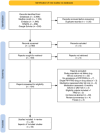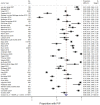Potentially inappropriate prescribing and falls-risk increasing drugs in people who have experienced a fall: a systematic review and meta-analysis
- PMID: 41118395
- PMCID: PMC12539572
- DOI: 10.1093/ageing/afaf300
Potentially inappropriate prescribing and falls-risk increasing drugs in people who have experienced a fall: a systematic review and meta-analysis
Abstract
Background: As certain medications increase risk of falls, it is important to review and optimise prescribing in those who have fallen to reduce risk of recurrent falls.
Objectives: To systematically review evidence on the prevalence and types of potentially inappropriate prescribing (PIP), including falls-risk increasing drug (FRID) use, in fallers.
Methods: A systematic search was conducted in July 2024 in MEDLINE, EMBASE, CINAHL and Google Scholar using keywords for fall events, inappropriate prescribing and FRIDs. Observational studies (cohort, case-control, cross-sectional, before-after) and randomised trials were included. Studies were eligible where participants had experienced a fall and PIP (including FRID use) was reported. Random-effects meta-analyses were conducted to pool prevalence of inappropriate prescribing and mean number of inappropriate prescriptions across studies, with stratified analysis to assess heterogeneity.
Results: Fifty papers reporting 46 studies met the inclusion criteria. All studies assessed FRIDs, and 29 assessed other PIP. The prevalence of PIP at the time of the fall was reported in 43 studies, and the pooled estimate was 68.6% (95% CI 66.1%-71.2%). Amongst 23 studies reporting it, the mean number of inappropriate prescriptions per participant was 2.21 (95%CI 1.98-2.45). The most common FRIDs prescribed were sedatives/hypnotics, opioids, diuretics and antidepressants. Twenty-one studies assessed changes in PIP prevalence post-fall; nine reported decreasing prevalence, with others noting increases/no change/mixed results.
Conclusion: Inappropriate prescribing is highly prevalent amongst fallers, with cardiovascular and psychotropic drugs being the most common. This suggests significant scope to optimise medicines use in these patients to potentially reduce falls risk and improve outcomes.
Keywords: falls-risk increasing drug; inappropriate; older people; potentially inappropriate prescribing; prescribing; prevalence.
© The Author(s) 2025. Published by Oxford University Press on behalf of the British Geriatrics Society.
Conflict of interest statement
None declared.
Figures




References
Publication types
MeSH terms
Grants and funding
LinkOut - more resources
Full Text Sources
Medical
Research Materials
Miscellaneous

